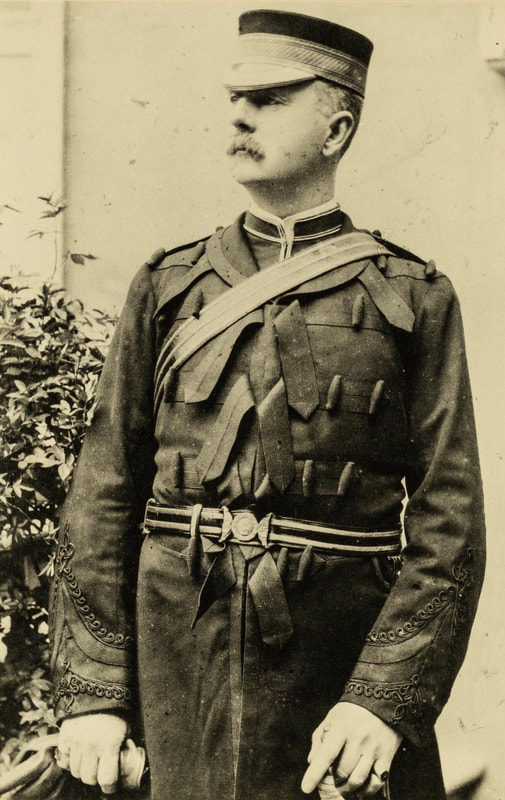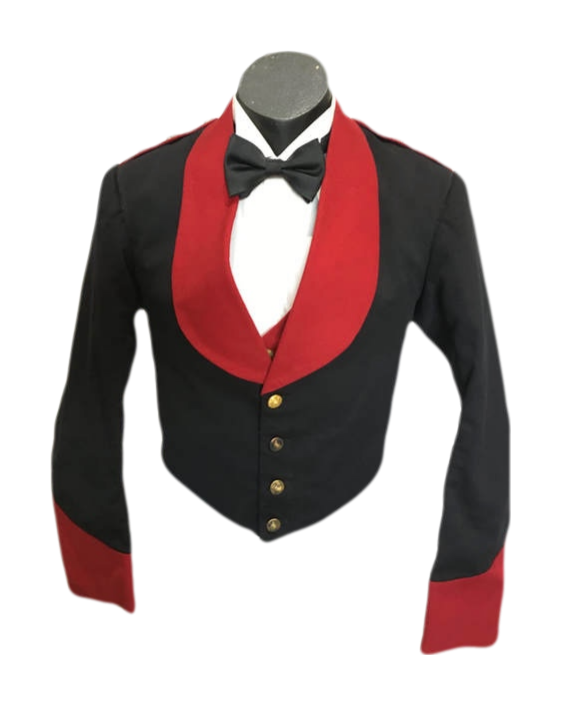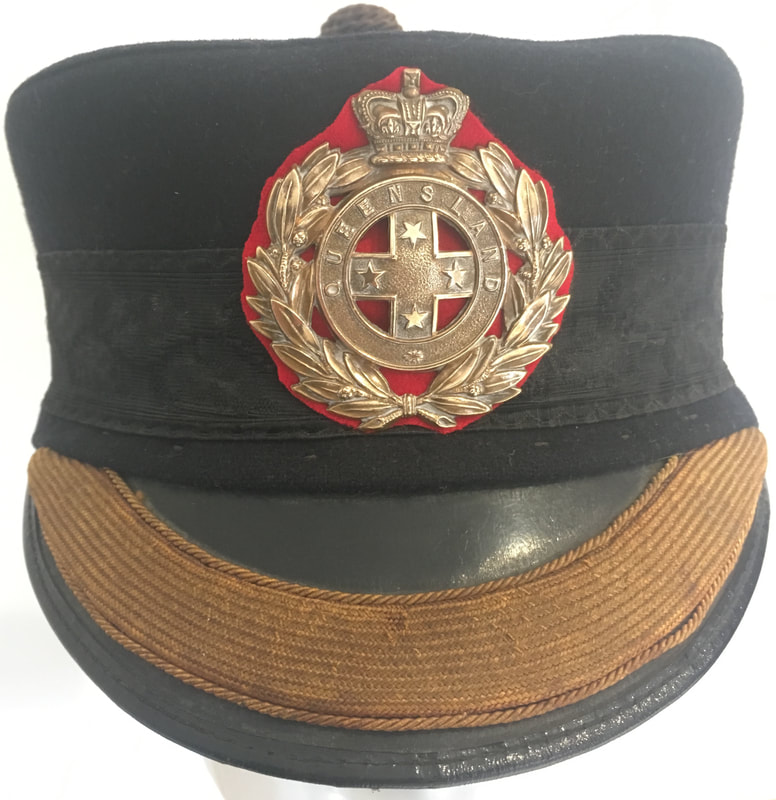Pre-federation
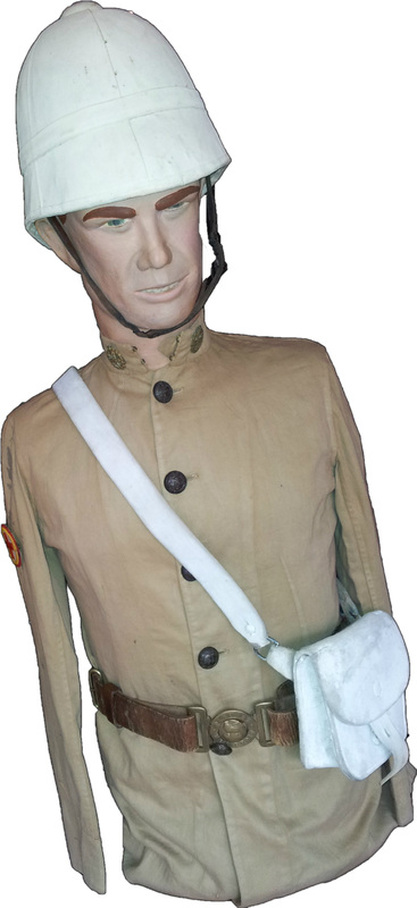
NSW Contingent to Sudan 1885
This uniform is of a Medic in the New South Wales (NSW) Ambulance Corps. Of the 700 volunteers raised in NSW that embarked for the Sudan Campaign, 34 were Ambulance Corps men.
The white blanco M1877 Foreign Service cork helmet was authorised for wear throughout the British Empire. This helmet has no puggaree (puggarees were authorised in 1900 Dress regulations after the Army Order 83 of 1896). It has a vent at the top and a leather adjustable chin strap.
The tunic is of khaki cotton cloth cut in the same style as the final Victorian-era Pattern 1881 British Army red tunic. This khaki tunic was specifically made for over seas service, with a high standing collar that secured with two hooks and eyes and also having two NSW collar badges at either end. The tunic has no pockets, which follows the 1881 style.
There were five blackened metal NSW embossed buttons extending down the front of the tunic.
On the right sleeve is a removable red Geneva Cross contained within a yellow circle worsted in thick cotton thread. This Medic Trade badge has four hooks that insert into eyes sewn onto the sleeve, so that the Badge can be removed for cleaning the tunic.
A 1871 Other Ranks Pattern Colonial brown leather waist belt has a large brass General Service Queen Victoria Crown buckle.
Over the right shoulder and resting on the left hip is a large buff white leather Medical Pouch. This would contain bandages and other items to administer first aid to the injured.
This uniform is of a Medic in the New South Wales (NSW) Ambulance Corps. Of the 700 volunteers raised in NSW that embarked for the Sudan Campaign, 34 were Ambulance Corps men.
The white blanco M1877 Foreign Service cork helmet was authorised for wear throughout the British Empire. This helmet has no puggaree (puggarees were authorised in 1900 Dress regulations after the Army Order 83 of 1896). It has a vent at the top and a leather adjustable chin strap.
The tunic is of khaki cotton cloth cut in the same style as the final Victorian-era Pattern 1881 British Army red tunic. This khaki tunic was specifically made for over seas service, with a high standing collar that secured with two hooks and eyes and also having two NSW collar badges at either end. The tunic has no pockets, which follows the 1881 style.
There were five blackened metal NSW embossed buttons extending down the front of the tunic.
On the right sleeve is a removable red Geneva Cross contained within a yellow circle worsted in thick cotton thread. This Medic Trade badge has four hooks that insert into eyes sewn onto the sleeve, so that the Badge can be removed for cleaning the tunic.
A 1871 Other Ranks Pattern Colonial brown leather waist belt has a large brass General Service Queen Victoria Crown buckle.
Over the right shoulder and resting on the left hip is a large buff white leather Medical Pouch. This would contain bandages and other items to administer first aid to the injured.

Surgeon 1889
This is a "undress" Patrol Jacket for a Medical Officer with the rank of Surgeon Lieutenant.
It is of dark blue melton wool fabric, having a stand-and-fall collar edged with black mohair braid. Hooks and eyes extending down the front to close the tunic and two mohair buttons to the epaulets. cascading down the front of the tunic are ten pointed black mohair lace set with black silk olivets.
Black Prussian braid indicating the rank of Lieutenant ornaments each cuff, and there are two worsted wire pips to the two epaulets.
On the inside of the jacket is black silk lining.
This is a "undress" Patrol Jacket for a Medical Officer with the rank of Surgeon Lieutenant.
It is of dark blue melton wool fabric, having a stand-and-fall collar edged with black mohair braid. Hooks and eyes extending down the front to close the tunic and two mohair buttons to the epaulets. cascading down the front of the tunic are ten pointed black mohair lace set with black silk olivets.
Black Prussian braid indicating the rank of Lieutenant ornaments each cuff, and there are two worsted wire pips to the two epaulets.
On the inside of the jacket is black silk lining.

Surgeons Frock Coat 1885 The first military frock coats were worn towards the end of the Napoleonic Wars by the French and Prussian troops who wore a loose fitting single breasted coat over their uniforms to prevent soiling to their expensive tail coats on campaign. In the 1840s a number of countries adopted the frock coat into their military attire, with the British adopting it after the 1857 Indian Mutiny. A number of styles existed depending on the Corps the wearer belong to. The style illustrated with a rolled collar was worn by the Medical Corps, and was typically worn by Colonial Medical Officers in Australia. The frock coat was made of a super fine black melton wool cloth with black frogging and lace to the front and rear of the coat. Embroidered rank is worn on the epaulettes and as cuff lace. Photographs depicting this coat in use is shown on the right and in the Colonial Section of the photo gallery. |

Boer War 1898 - 1901
This uniform is of a Medic in the South Australian Contingent in the Boer War.
The khaki felt slouch hat has a turn up brim and press stud on the left. There is a brown leather band around the crown
The tunic is a British 1899 pattern issued to Australian troops made of coarse khaki wool serge material, with a high standing collar. There are two box pleated breast pockets and two larger lower pockets, all with straight flaps.
All buttons are Queen Victoria Crown (QVC) general pattern extending down the front, the pockets and epaulets.
Sewn onto the right sleeve is a worsted Red Geneva Cross contained within a yellow circle, all done with thick cotton thread.
Other ranks 1888 Pattern (Mk 1) British Valise equipment (also known as Slade-Wallace equipment) is worn, and is made of Buff white leather. There are two (left and right) Braces over the shoulders that take the weight of the waist belt and attached equipment. For Infantry, the Braces attach to the back of two ammunition pouches, but for Medics, who require no ammunition pouches, there were two front suspension loops. The 2nd pattern 1891 waist belt has a large brass circular buckle with a QVC. A Bayonet Frog (Mk 1 General Service 1890) is on the left of the belt and has a P1878 Martini Henry Artillery Sawback bayonet that was issued to the Army Medical Corps.
Suspended over the left shoulder is a large white cotton calico Medics bag rests against the right hip. This contains bandages and other medical items to administer first aid.
This uniform is of a Medic in the South Australian Contingent in the Boer War.
The khaki felt slouch hat has a turn up brim and press stud on the left. There is a brown leather band around the crown
The tunic is a British 1899 pattern issued to Australian troops made of coarse khaki wool serge material, with a high standing collar. There are two box pleated breast pockets and two larger lower pockets, all with straight flaps.
All buttons are Queen Victoria Crown (QVC) general pattern extending down the front, the pockets and epaulets.
Sewn onto the right sleeve is a worsted Red Geneva Cross contained within a yellow circle, all done with thick cotton thread.
Other ranks 1888 Pattern (Mk 1) British Valise equipment (also known as Slade-Wallace equipment) is worn, and is made of Buff white leather. There are two (left and right) Braces over the shoulders that take the weight of the waist belt and attached equipment. For Infantry, the Braces attach to the back of two ammunition pouches, but for Medics, who require no ammunition pouches, there were two front suspension loops. The 2nd pattern 1891 waist belt has a large brass circular buckle with a QVC. A Bayonet Frog (Mk 1 General Service 1890) is on the left of the belt and has a P1878 Martini Henry Artillery Sawback bayonet that was issued to the Army Medical Corps.
Suspended over the left shoulder is a large white cotton calico Medics bag rests against the right hip. This contains bandages and other medical items to administer first aid.
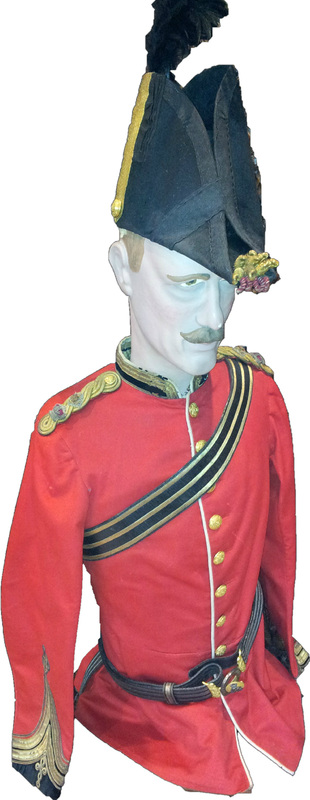
Officers Dress Tunic and Fore-aft hat of the Medical Staff Corps 1888
New South Wales Medical Staff Corps Staff Surgeon Williams was appointed as the Principal Medical Officer with the rank of Lieutenant Colonel.
The black fore-aft hat or bicorne hat has braiding along the crest and a gold and crimson wire tassel at both ends. On the right hand side of the hat is a gold wire braid terminating in a gold plated Medical Staff button. A black feather hackle is also inserted into the top of the right hand turn up.
The tunic is of fine red melton cloth with black velvet facings and edged with white cloth piping. There are no external pockets. All the gold plated buttons extending down the front of the tunic have embossed the Queen Victoria Crown (QVC) and the words 'Medical Staff Corps'.
Both sleeves and collar have gold wire Prussian braiding indicating the rank of Lieutenant Colonel. There are two gold wire intwined cord epaulets and on each having a silver wire QVC and pip.
Over the left shoulder is a gold wire braided black leather shoulder belt and pouch to the rear. A gold wire braided black leather parade belt and an ornate Medical Staff Corps gold plated belt buckle and clasp is to the front. A sword suspension belt hangs from the waist belt.
New South Wales Medical Staff Corps Staff Surgeon Williams was appointed as the Principal Medical Officer with the rank of Lieutenant Colonel.
The black fore-aft hat or bicorne hat has braiding along the crest and a gold and crimson wire tassel at both ends. On the right hand side of the hat is a gold wire braid terminating in a gold plated Medical Staff button. A black feather hackle is also inserted into the top of the right hand turn up.
The tunic is of fine red melton cloth with black velvet facings and edged with white cloth piping. There are no external pockets. All the gold plated buttons extending down the front of the tunic have embossed the Queen Victoria Crown (QVC) and the words 'Medical Staff Corps'.
Both sleeves and collar have gold wire Prussian braiding indicating the rank of Lieutenant Colonel. There are two gold wire intwined cord epaulets and on each having a silver wire QVC and pip.
Over the left shoulder is a gold wire braided black leather shoulder belt and pouch to the rear. A gold wire braided black leather parade belt and an ornate Medical Staff Corps gold plated belt buckle and clasp is to the front. A sword suspension belt hangs from the waist belt.
|
1898 Queensland Defence Force Medical Officer
Joseph Espie Dods (JED) was born in London in July 1874. Arrived in Melbourne with his mother and siblings in 1878 and moved to Brisbane in 1880 attending BGS. He studied Medicine in Scotland and graduated as a medical practitioner on 10 Aug 1897. He then returned to Brisbane and enlisted in the QLD Defence Force (QDF) as a Lieutenant in 1897, then promoted Captain in the Medical Staff of the QDF in 1898. On 10th May 1899 he was posted to No. 1 Company in Brisbane as MO. In Oct 1899 JED was selected to be the MO of the Queensland Mounted Infantry for the Boer War. He later served at ANZAC with the 5th LH, and the Somme with the 1st Division AIF. 1898 Dr Joseph Dods Medical Corps Mess Dress of the QDF Black waist jacket of melton cloth, with maroon facings, collars and epaulettes - these having 2 embroidered wire pips on each. Maroon cotton inner waist coat. QV crown Medical Staff Corps Officers gold plated buttons to the waist coat and Mess Dress jacket. |
|
1900. Senior NCO Forage cap.
3rd Kennedy Regiment Medical Corps. A brass Queensland Helmet Plate is affixed to the front. The NCO Forage cap is made from dark blue wool with a bullion top button and black ribbon braid, an oak leaf band around the crown and a short black peak, edged in golden yellow cotton braid. NCO's caps were edged in this type of braid, whereas Officers Forage caps had silver or gold wire bullion braid. |

